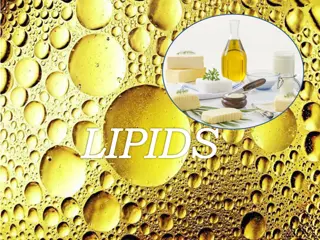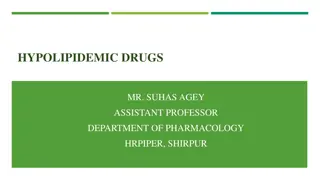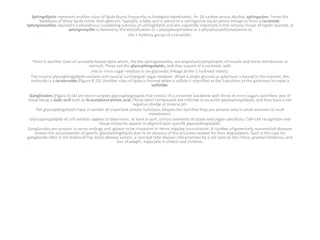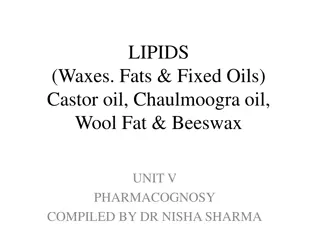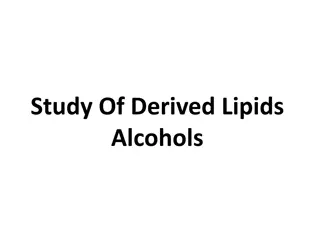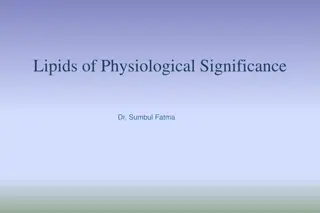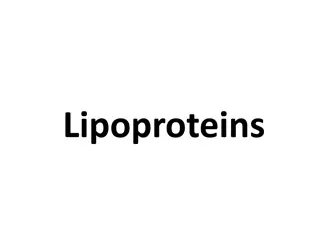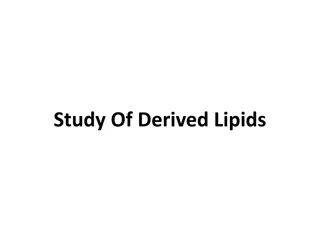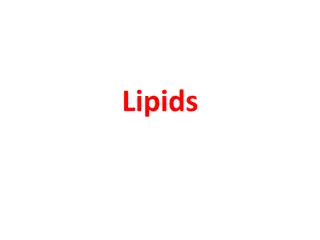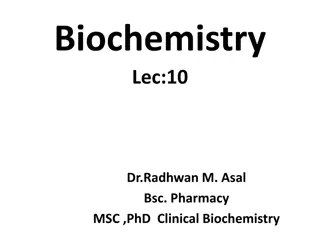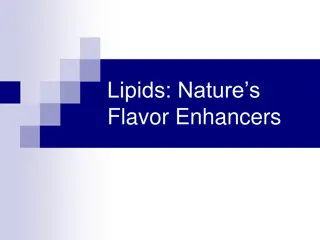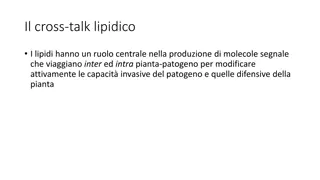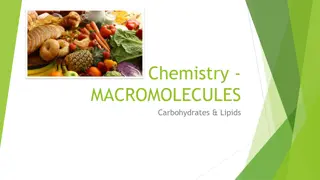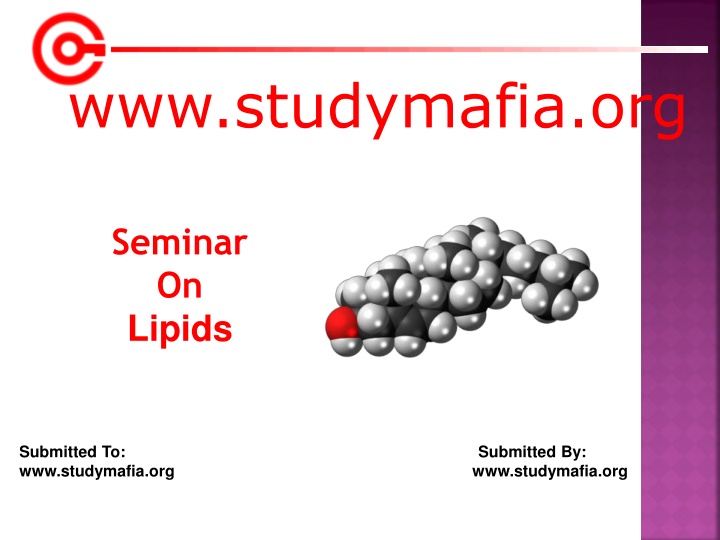
The Significance of Lipids in Biology
Explore the world of lipids - an essential component in cellular structure and energy storage. Learn about their definition, importance, functions, and major types. Discover the key role lipids play in hormone synthesis, membrane fluidity, and more.
Download Presentation

Please find below an Image/Link to download the presentation.
The content on the website is provided AS IS for your information and personal use only. It may not be sold, licensed, or shared on other websites without obtaining consent from the author. If you encounter any issues during the download, it is possible that the publisher has removed the file from their server.
You are allowed to download the files provided on this website for personal or commercial use, subject to the condition that they are used lawfully. All files are the property of their respective owners.
The content on the website is provided AS IS for your information and personal use only. It may not be sold, licensed, or shared on other websites without obtaining consent from the author.
E N D
Presentation Transcript
www.studymafia.org Seminar On Lipids Submitted To: www.studymafia.org www.studymafia.org Submitted By:
CONTENTS Introduction Definition Importance of Lipids Functions Major Lipids Of Physiological Significance Applications Advantages Disadvantages References
INTRODCUTION The word lipid is derived from a greek word lipos which means FAT. These are heterogenous group of compounds Unlike proteins,nucleic acids,polysaccharides,lipids are not polymers rather they are small molecules. They are the chief storage form of energy,besides their role in cellular structure and other biochemical functions.
DEFINITION Lipids may be regarded as organic substances relatively insoluble in water, soluble in organic solvents, actually or potentially related to fatty acids and utilized by the living cells.
WHY LIPIDS ARE IMPORTANT Lipids are important to the body because;- Important constituent of the cell membranes. Helps in the absorption of fat soluble vitamins. Maintains membrane fluidity. Acts as a thermal insulator and cellular metabolic regulator. Hormone synthesis. Organ padding .
FUNCTIONS Fat is stored in adipose tissue, where it also serves as a thermal insulator in the subcutaneous tissues. Fatty acid derivatives serve as vitamins(A,D,E&K) or hormones. It act as energy/food reservoir (Triacylglycerol). Several proteins are covalently modified by fatty acids. Structural components of biological membranes (lipoprotein, phospholipids &sphingomyelins) .
MAJOR LIPIDS OF PHYSIOLOGICAL SIGNIFICANCE;- Fatty acids ;-basic units of fat composed of chains of carbon atoms with an acid group at one end and hydrogen atoms attached all along their length. Present as either esterified or unesterified form in fats and oils.
CLASSIFICATION OF FATTY ACIDS;- Fatty acids Saturated FA Unsaturated FA
SATURATED FATTY ACIDS;- Saturated fatty contains no double bonds (having no points of unsaturation). Saturated fats- considered as harmful. It increases total cholesterol level and TGs level. Hypercholestrolemic SFAs are-Myristic acid & Lauric acid.
UNSATURATED FATTY ACIDS;- Unsaturated fatty acid: a fatty acid with one or more points of unsaturation. Unsaturated fats are found in foods from both plant and animal sources. Unsaturated fatty acids are further divided into monounsaturated fatty acids and polyunsaturated fatty acids.
DIVISIONS OF UNSATURATED FATTY ACIDS;- Unsaturated Fatty acids MUFA PUFA Eicosanoids
MONOUNSATURATED FATTY ACIDS;- Monounsaturated fatty acid: a fatty acid containing one point of unsaturation, found mostly in vegetable oils such as olive, canola, and peanut. They are considered as beneficial for human health. MUFA Trans FA Cis FA
CIS- UNSATURATED FATTY ACIDS;- In cis bonds, the two pieces of the carbon chain on either side of the double bond are either both up or both down, such that both are on the same side of the molecule. Significance Decreases total cholesterol and TGs level. Increases HDL level.
TRANS UNSATURATED FATTY ACIDS;- Trans fatty acids are produced by hydrogenation process. Hydrogen atoms are on the opposite sides of the molecule. Eg.cis-oleic acid trans-elaidic acid PHYSIOLOGICAL EFFECTS OF TRANS FATTY ACIDS - SERUM LIPIDS -SYSTEMIC INFLAMMATION -ENDOTHELIAL-CELL FUNCTION
Physiological effects of trans fatty acids continued SERUM LIPIDS >raises levels of low-density lipoprotein (LDL) cholesterol reduces levels of high-density lipoprotein (HDL) cholesterol >increases the ratio of total cholesterol to HDL cholesterol, a powerful predictor of the risk of CHD >increase the blood levels of triglycerides , of Lp(a) lipoprotein, and reduce the particle size of LDL cholesterol: further raise the risk of CHD. >trans fatty acids have markedly adverse effects on serum lipids
Physiological effects of trans fatty acids continued Systemic inflammation inflammation: an independent risk factor for atherosclerosis, sudden death from cardiac causes, diabetes, and heart failure the inflammatory effects of trans fats may account in part for their effects on cardiovascular health For example, the difference in C-reactive protein levels ; 2.1 percent vs 0.9 percent intake: an increase in cardiovascular risk of approximately 30 percent.
Physiological effects of trans fatty acids continued ENDOTHELIAL-CELL FUNCTION-- increased levels of several markers of endothelial dysfunction: for eg;- soluble intercellular adhesion molecule, soluble vascular- cell adhesion molecule, and E-selectin
POLYUNSATURATED FATTY ACIDS;- Polyunsaturated fatty acids (sometimes abbreviated PUFA) are those fatty acids where unsaturation occur more than two points, found in nuts and vegetable oils such as safflower, sunflower, and soybean, and in fatty fish. They possess protective role on human health.considered as beneficial for consumpmtion.
PUFA continued;- Increase esterification process of cholesterol & prevents its absorption. By increasing the synthesis of eicosanoids. Acts as an anti platelet aggregating factor, so decreases the chances of clot formation. Decreases the synthesis of the precursor of VLDL AND TGs. Increases clearance of LDL cholesterol.
Omega-3-fatty acids- Benefits- >Lower PGE2s level >Anti-inflammatory >Lower triglyceride and cholesterol levels >Benefits vision and >brain function >Decrease Skin >inflammation >Inhibit platelet adhesion >Increase insulin sensitivity
OMEGA-6 FATTY ACIDS- Linoleic fatty acid Arachidonic acid Benefits- Platelet aggregation, cardiovascular diseases, and inflammation. Reduce the symptoms of eczema and psoriasis. Clear up different types of acne.
EICOSANOIDS;- These compounds are derived from long chain polyenoic fatty acids (20-carbon). Examples of eicosanoids;- Prostaglandins. Prostacyclines, Thromboxanes Leukotrienes lipoxins They have roles in: Inflammation Fever Regulation of blood pressure Blood viscosity Male fertility Female conception Muscle cotraction Blood clotting Tissue growth Regulation of sleep/wake cycle Bronchocostriction Asthma.
TRIGLYCERIDES;- Structure Glycerol + 3 fatty acids Functions Energy source--9 kcals per gram Form of stored energy in adipose tissue. Insulation and protection Carrier of fat-soluble vitamins Sensory properties in food
PHOSPHOLIPIDS;- MAIN LIPID CONSTITUENT OF CELL MEMBRANE. Structure Glycerol + 2 fatty acids + phosphate group also considered as derivative of phosphatidic acid . Functions Main lipid constituent of cell membranes Lipid transport as part of lipoproteins Emulsifiers Cell signalling process. phospholipids Phos.choline phos.inositol cardiolipin lysophospholipid plasmalogens sphingomy.
STEROLS;- Steroids are the compounds contains cyclic steroid nucleus namely cyclo pentanophenanthrene ring. Cholesterol- best known steroid because of its association with atherosclerosis and heart diseases. Contains same steroid nucleus. Exclusively present in animals . Functions;- --Bile acids Sex hormones Adrenal hormones Vitamin D --Cardiac glycosides
GLYCOLIPIDS;- --widely distributed in the body Fatty acids + sphingosine +carbohydrate Also k/a glycosphingolipids. Present in cell membrane and nervous tissues. It contributes to cell surface carbohydrate Other glycolipids are;- Cerebrosides- simplest form of glycolipids.contains ceramides. eg. Galactosylcerebrosides glucosylcerebrosides Gangliosides predominantly found in ganglions.Complex glycolipids
LIPOPROTEINS;- Lipoproteins are th macromolecular complex of lipids and proteins. Transportation of lipids in the blood. Structure of lipoproteins;- Hydrophobic lipids (TG, CE) in core; Hydrophilic lipids (UC, PL) on surface
CLASSES OF LIPOPROTEINS;- Chylomicrons, VLDL, LDL HDL > 30 nm 20 22 nm 9 15 nm D<1.006 g/ml D=1.019-1.063g/ml D=1.063-1.21 g/ml Doi H et al. Circulation 2000;102:670-676; Colome C et al. Atherosclerosis 2000; 149:295-302; Cockerill GW et al. Arterioscler Thromb Vasc Biol 1995;15:1987-1994
The Effects of Various Types of Fat on Blood Lipid Levels Saturated Fat Increases total cholesterol Increases LDL-cholesterol Polyunsaturated Fat Decreases total cholesterol Decreases LDL-cholesterol Decreases HDL-cholesterol Monounsaturated Fat Decreases total cholesterol Decreases LDL-cholesterol Increases HDL-cholesterol
Omega-3 Fat Decreases total cholesterol Decreases LDL-cholesterol Increases HDL-cholesterol Decreases serum triglycerides Trans Fat Increases total cholesterol Increases LDL-cholesterol
ADVANTAGES OF LIPIDS Roles in Your Body Provide Energy Absorption of Vitamins Few are Essential Fatty Acids for Body
DISADVANTAGES OF LIPIDS Raise Your Susceptibility to Heart Disease Lead to Weight Gain Make You Insulin-Resistant Raise Your Cancer Risk
APPLICATIONS OF LIPIDS Studies of fatty acid metabolism using hydrogen isotopes General synthesis of R1-(CH=CH-CH2)n-R2- COOH (n < 4) Fatty Acids Metabolism of Unstable Eicosanoids: Role of Prostaglandin E Synthases 7,10,13-Hexadecatrienoic acid and Hexadecanoids Occurrence & Biosynthesis in Plants Conjugated Polyenoic Fatty Acids and Metabolites
REFERENCES www.google.com www.wikipedia.com www.studymafia.org

